Color charge
Colour charge is a property of quarks and gluons that is related to the particles' strong interactions in the theory of quantum chromodynamics (QCD).
| Standard Model of particle physics |
|---|
 |
The "colour charge" of quarks and gluons is completely unrelated to the everyday meanings of color and charge. The term colour and the labels red, green, and blue became popular simply because of the loose analogy to the primary colours.
History
Shortly after the existence of quarks was proposed by Murray Gell-Mann and George Zweig in 1964, Moo-Young Han and Yoichiro Nambu introduced a hidden internal degree of freedom in which quark wave functions were antisymmetric, thus solving the spin-statistics problem of the Gell Mann-Zweig quark model.
Han and Nambu initially designated this degree of freedom by the group SU(3)', but it was referred to in later papers as "the three triplet model." One feature of the model (which was originally preferred by Han and Nambu) was that it permitted integrally charged quarks, as well as the fractionally charged quarks initially proposed by Zweig and Gell-Mann.
Somewhat later, in the early 1970s, Gell-Mann, in several conference talks, coined the name "Color" to describe the internal degree of freedom of the three triplet model, and advocated a new field theory, designated as "Quantum Chromodynamics" (QCD) to describe the interaction of quarks and gluons within hadrons. In Gell-Mann's QCD, each quark and gluon had fractional electric charge, and carried what came to be called "Color Charge" in the space of the Color degree of freedom.
Red, green, and blue
In quantum chromodynamics (QCD), a quark's colour can take one of three values or charges: red, green, and blue. An antiquark can take one of three anticolors: called antired, antigreen, and antiblue (represented as cyan, magenta, and yellow, respectively). Gluons are mixtures of two colours, such as red and antigreen, which constitutes their colour charge. QCD considers eight gluons of the possible nine colour–anticolor combinations to be unique; see eight gluon colours for an explanation.
All three colours mixed together, or any one of these colours and its complement (or negative), is "colourless" or "white" and has a net colour charge of zero. Due to a property of the strong interaction called colour confinement, free particles must have a colour charge of zero.
A baryon is composed of three quarks, which must be one each of red, green, and blue colours; likewise an antibaryon is composed of three antiquarks, one each of antired, antigreen and antiblue. A meson is made from one quark and one antiquark; the quark can be any colour, and the antiquark has the matching anticolor.
The following illustrates the coupling constants for color-charged particles:
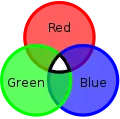 The quark colors (red, green, blue) combine to be colorless
The quark colors (red, green, blue) combine to be colorless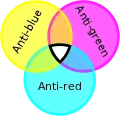 The quark anticolors (antired, antigreen, antiblue) also combine to be colorless
The quark anticolors (antired, antigreen, antiblue) also combine to be colorless
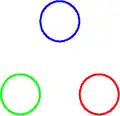 A hadron with 3 quarks (red, green, blue) before a color change
A hadron with 3 quarks (red, green, blue) before a color change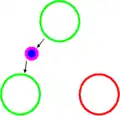 Blue quark emits a blue–antigreen gluon
Blue quark emits a blue–antigreen gluon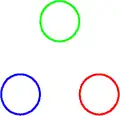 Green quark has absorbed the blue–antigreen gluon and is now blue; color remains conserved
Green quark has absorbed the blue–antigreen gluon and is now blue; color remains conserved An animation of the interaction inside a neutron. The gluons are represented as circles with the color charge in the center and the anti-colour charge on the outside.
An animation of the interaction inside a neutron. The gluons are represented as circles with the color charge in the center and the anti-colour charge on the outside.
Field lines from colour charges
Analogous to an electric field and electric charges, the strong force acting between color charges can be depicted using field lines. However, the colour field lines do not arc outwards from one charge to another as much, because they are pulled together tightly by gluons (within 1 fm).[1] This effect confines quarks within hadrons.
.svg.png.webp)
Top: Color charge has "ternary neutral states" as well as binary neutrality (analogous to electric charge).
Bottom: Quark/antiquark combinations.[2][3]
Coupling constant and charge
In a quantum field theory, a coupling constant and a charge are different but related notions. The coupling constant sets the magnitude of the force of interaction; for example, in quantum electrodynamics, the fine-structure constant is a coupling constant. The charge in a gauge theory has to do with the way a particle transforms under the gauge symmetry; i.e., its representation under the gauge group. For example, the electron has charge −1 and the positron has charge +1, implying that the gauge transformation has opposite effects on them in some sense. Specifically, if a local gauge transformation ϕ(x) is applied in electrodynamics, then one finds (using tensor index notation):
where is the photon field, and ψ is the electron field with Q = −1 (a bar over ψ denotes its antiparticle — the positron). Since QCD is a non-abelian theory, the representations, and hence the colour charges, are more complicated. They are dealt with in the next section.
Quark and gluon fields
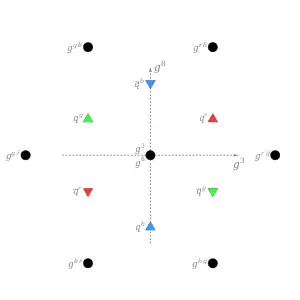
In QCD the gauge group is the non-abelian group SU(3). The running coupling is usually denoted by . Each flavour of quark belongs to the fundamental representation (3) and contains a triplet of fields together denoted by . The antiquark field belongs to the complex conjugate representation (3*) and also contains a triplet of fields. We can write
- and
The gluon contains an octet of fields (see gluon field), and belongs to the adjoint representation (8), and can be written using the Gell-Mann matrices as
(there is an implied summation over a = 1, 2, ... 8). All other particles belong to the trivial representation (1) of color SU(3). The color charge of each of these fields is fully specified by the representations. Quarks have a colour charge of red, green or blue and antiquarks have a colour charge of antired, antigreen or antiblue. Gluons have a combination of two colour charges (one of red, green, or blue and one of antired, antigreen, or antiblue) in a superposition of states which are given by the Gell-Mann matrices. All other particles have zero colour charge. Mathematically speaking, the colour charge of a particle is the value of a certain quadratic Casimir operator in the representation of the particle.
In the simple language introduced previously, the three indices "1", "2" and "3" in the quark triplet above are usually identified with the three colours. The colourful language misses the following point. A gauge transformation in colour SU(3) can be written as , where is a 3 × 3 matrix which belongs to the group SU(3). Thus, after gauge transformation, the new colours are linear combinations of the old colours. In short, the simplified language introduced before is not gauge invariant.

Colour charge is conserved, but the book-keeping involved in this is more complicated than just adding up the charges, as is done in quantum electrodynamics. One simple way of doing this is to look at the interaction vertex in QCD and replace it by a colour-line representation. The meaning is the following. Let represent the i-th component of a quark field (loosely called the i-th colour). The colour of a gluon is similarly given by which corresponds to the particular Gell-Mann matrix it is associated with. This matrix has indices i and j. These are the colour labels on the gluon. At the interaction vertex one has qi → gi j + qj. The 'colour-line representation tracks these indices. Colour charge conservation means that the ends of these colour lines must be either in the initial or final state, equivalently, that no lines break in the middle of a diagram.

Since gluons carry colour charge, two gluons can also interact. A typical interaction vertex (called the three gluon vertex) for gluons involves g + g → g. This is shown here, along with its colour-line representation. The colour-line diagrams can be restated in terms of conservation laws of colour; however, as noted before, this is not a gauge invariant language. Note that in a typical non-abelian gauge theory the gauge boson carries the charge of the theory, and hence has interactions of this kind; for example, the W boson in the electroweak theory. In the electroweak theory, the W also carries electric charge, and hence interacts with a photon.
See also
References
- R. Resnick, R. Eisberg (1985), Quantum Physics of Atoms, Molecules, Solids, Nuclei and Particles (2nd ed.), John Wiley & Sons, p. 684, ISBN 978-0-471-87373-0
- Parker, C.B. (1994), McGraw Hill Encyclopaedia of Physics (2nd ed.), Mc Graw Hill, ISBN 978-0-07-051400-3
- M. Mansfield, C. O’Sullivan (2011), Understanding Physics (4th ed.), John Wiley & Sons, ISBN 978-0-47-0746370
Further reading
- Georgi, Howard (1999), Lie algebras in particle physics, Perseus Books Group, ISBN 978-0-7382-0233-4.
- Griffiths, David J. (1987), Introduction to Elementary Particles, New York: John Wiley & Sons, ISBN 978-0-471-60386-3.
- Christman, J. Richard (2001), "Colour and Charm" (PDF), PHYSNET document MISN-0-283.
- Hawking, Stephen (1998), A Brief History of Time, Bantam Dell Publishing Group, ISBN 978-0-553-10953-5.
- Close, Frank (2007), The New Cosmic Onion, Taylor & Francis, ISBN 978-1-58488-798-0.